GBP/JPY Price Analysis: The bullish outlook remains intact above 205.50

- GBP/JPY holds positive ground amid near 205.70 in Tuesday’s European session.
- The cross maintains the bullish contents on the daily chart, above bullish territory.
- The first upside barrier is seen at 206.35; the 100-period EMA at 205.60 acts as an initial support level for the cross.
The GBP/JPY cross recovers some lost ground near 205.70, snapping the three-day losing streak during the early European session on Tuesday. The upside of the cross might be limited as further potential forex (FX) intervention by the Bank of Japan (BoJ) might prevent the JPY from depreciating.
According to the 4-hour chart, the bullish outlook of the cross remains intact as it holds above the key 100-period Exponential Moving Average (EMA). However, further consolidation cannot be ruled out as the Relative Strength Index (RSI) hovers around the 50-midline, indicating the neutral momentum of the cross.
The first upside barrier for GBP/JPY will emerge at 206.35, a high of July 12. Extended gains will see a rally to 206.67, a high of July 8. Any follow-through buying about this level will pave the way to the 207.60–207.70 region, portraying the upper boundary of the Bollinger Band and a high of July 10.
On the downside, the 100-period EMA at 205.60 acts as an initial support level for the cross. A breach of this level will seea drop to 203.50. Further south, the next contention level is seen at the 203.00 psychological level.
GBP/JPY 4-hour chart
Pound Sterling FAQs
The Pound Sterling (GBP) is the oldest currency in the world (886 AD) and the official currency of the United Kingdom. It is the fourth most traded unit for foreign exchange (FX) in the world, accounting for 12% of all transactions, averaging $630 billion a day, according to 2022 data. Its key trading pairs are GBP/USD, aka ‘Cable’, which accounts for 11% of FX, GBP/JPY, or the ‘Dragon’ as it is known by traders (3%), and EUR/GBP (2%). The Pound Sterling is issued by the Bank of England (BoE).
The single most important factor influencing the value of the Pound Sterling is monetary policy decided by the Bank of England. The BoE bases its decisions on whether it has achieved its primary goal of “price stability” – a steady inflation rate of around 2%. Its primary tool for achieving this is the adjustment of interest rates. When inflation is too high, the BoE will try to rein it in by raising interest rates, making it more expensive for people and businesses to access credit. This is generally positive for GBP, as higher interest rates make the UK a more attractive place for global investors to park their money. When inflation falls too low it is a sign economic growth is slowing. In this scenario, the BoE will consider lowering interest rates to cheapen credit so businesses will borrow more to invest in growth-generating projects.
Data releases gauge the health of the economy and can impact the value of the Pound Sterling. Indicators such as GDP, Manufacturing and Services PMIs, and employment can all influence the direction of the GBP. A strong economy is good for Sterling. Not only does it attract more foreign investment but it may encourage the BoE to put up interest rates, which will directly strengthen GBP. Otherwise, if economic data is weak, the Pound Sterling is likely to fall.
Another significant data release for the Pound Sterling is the Trade Balance. This indicator measures the difference between what a country earns from its exports and what it spends on imports over a given period. If a country produces highly sought-after exports, its currency will benefit purely from the extra demand created from foreign buyers seeking to purchase these goods. Therefore, a positive net Trade Balance strengthens a currency and vice versa for a negative balance.
